Diamond Color vs. Clarity – Which One Should Take Priority?
A diamond with perfect color would be colorless, whereas a diamond with excellent clarity would be without any imperfections. A diamond’s carats reveals its exact weight and size, and its cut will determine how much it sparkles or its brilliance.
These four grades all determine the value and price of the diamond. Everyone agrees that “cut is king” so there is no wiggle room there. But, which one should you focus on once you’ve decided on the cut when it comes to choosing between diamond color vs. clarity? Should you compromise on the color or rather on the clarity to get the best diamond for the best price?
Regarding diamonds, when it comes to color and clarity, you can easily forego perfection if you really want to get the most for your money. There are specific tips to help you find diamonds with lower color and/or clarity grades, but in reality, look absolutely perfect with the naked eye. You can save quite a bit of money by using these tips on diamond color vs. clarity!
In this blog post we’ll cover:
- How to save money by compromising on diamond clarity
- Where to find eye-clean low clarity diamonds
- How to save money compromising on diamond color
- Diamond color simulator and buying recommendations
- Guidelines on when to prioritize color and when diamond clarity
- Diamond shapes that help to conceal low diamond clarity
- Final summary of recommendations
Compromising on Diamond Clarity

You can save a lot of money if you can find an eye-clean diamond, one with no visible inclusions. What many people don’t know is that you don’t need a high clarity grade for that. In fact, you can choose a low clarity grade and still find a stunning loose diamond for your diamond engagement ring.
I’ve seen a lot of diamonds in my career, and if you look at diamonds with a GIA clarity grade of VS1 or higher, you’ll know that they’re all eye-clean. My advice would be that to get the most for your money, focus on diamonds with VS2, SI1, and SI2 clarity grades.
Diamonds with these clarity grades are relatively inexpensive, and you can find some beautiful stones among them. While looking at these diamonds, you’ll see some that are definitely NOT eye-clean. This is why it is crucial that you look very closely into every single diamond before making your choice.
The idea is to find an eye-clean diamond with a clarity grade of SI1 or SI2 if at all possible. This would save you quite a bit of money, and you would have a beautiful diamond with no visible inclusions.
Here you can see two examples of eye-clean vs., not eye-clean diamonds. Both lie within the SI12 – SI2 clarity range:
An Inside Tip: How to find eye-clean low clarity diamonds
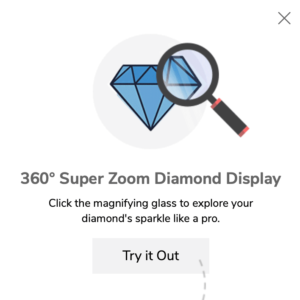
If you search for diamonds on James Allen, you would be able to see into them with a 20x magnifier, but using their Super Zoom function, you could see into each diamond with up to 40x magnification.
The truth is that when a diamond is graded, a loupe with 10x magnification is used. Using the Super Zoom at James Allen, you’ll be able to see tiny inclusions in diamonds that have been officially IF-graded, meaning “internally flawless.”
Therefore, if you honestly want to know whether a diamond is genuinely eye-clean or not, make sure you at least look into it with a standard 20x magnifier. If it has a very noticeable inclusion, then this diamond is definitely NOT eye-clean. But, if you can hardly see it with the 20x magnifier or perhaps only see it from a particular angle, then it most likely is eye-clean.
I always recommend my blog to check out James Allen. James Allen offers 360° videos and also a Super Zoom function that lets you take a close look at each diamond. That way, you can quickly determine whether a diamond is eye clean or not.
Just be patient and take your time, and you will surely come across eye-clean diamonds within the recommended clarity grades. When you compromise on the clarity of a diamond, the trick is to make sure it’s eye-clean. A slight compromise on anything else wouldn’t be noticeable, but when a diamond has visible inclusions, it definitely distracts from its beauty. Keep this in mind when evaluating the differences between the diamond’s color vs. clarity.
Compromising on Diamond Color
You can compromise far more easily on diamond color than you can on its clarity. It’s as easy as selecting the color grade you prefer most. But, keep in mind that the lower you go in clarity grade, the more money you’ll save. Look at the table below, and you will see how the prices go up according to the diamond’s color grade when everything else remains the same:

You’ll remember what I posted in my blog about diamond color when you select a diamond with a color grade above G you cannot expect the best ratio between cost and performance. Furthermore, it is improbable that anyone would notice the slightest hint of color in a top grade diamond. Have a look at the Diamond Color Simulator below to see what each color grade is supposed to look like:
Diamond Color Simulator
Click here to get to the simulator
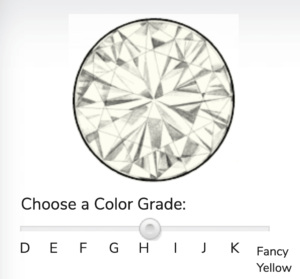
To get the most for your money on a diamond ring, follow my recommendations below regarding diamond shape, diamond color, and ring-setting:
| Diamond Shape | Silver, White Gold or Platinum Ring Settings | Yellow Gold Ring Settings |
| Emerald Cut Diamond | To avoid augmenting any hint of yellow in your Emerald shaped diamond, choose a color grade of G, H or I. | J or K
|
| Round Cut Diamond | Round diamonds are best at concealing low color grades, as long as the round diamond has a color grade of H, I or J. | K, L or M |
| Princess Cut Diamond | Princess cut diamonds look best in these ring settings if the color grade is no lower than G, H or I. | J or K |
| Cushion Cut Diamond | Cushion cut diamonds retain more color than other cuts so the color grade you choose will be important. Choose a color grade of H or higher if your cushion cut diamond in one of these settings. | I or higher |
| Pear Cut Diamond | Pear-shaped diamonds also show more color than a lot of other shapes. Choose a color grade of F, G or H for these ring settings. | I or J |
| Asscher Cut Diamond | If you have an Asscher-cut diamond choose a color grade of G, H or I for any of these ring settings. | K or J |
| Oval Cut Diamond | For an Oval shaped diamond, your priority should be color. For these ring settings, choose one with an F, G or H color grade. | I or J |
(remember that the diamond cut is different from the diamond shape)
Which Should Take Priority: Diamond Color vs. Clarity?
A Beginner’s Chart Can Help You Decide
If you’ve never bought a diamond before, you’re probably trying to find out as much as you can to avoid being ripped off. You may have already decided which diamond shape you want and may even have chosen a setting. If you’ve dug into the research, you’ve likely learned that gemologists grade diamonds according to the 4 Cs, which are clarity, color, cut, and carat.
As I mentioned before, a diamond with perfect color would be colorless, whereas a diamond with excellent clarity would be one without any imperfections. The number of carats is its exact weight and size, and the diamond’s particular cut determines how much it sparkles or its brilliance. The grade of each of these Cs is taken into consideration when the value (or price) is set. But, which of these takes priority, diamond color vs. clarity?
How the Diamond Clarity & Color Chart Can Help
 If you don’t have all the money in the world, you probably cannot afford to pay top dollar for a diamond graded highly in all 4 categories. Diamonds with high grades, especially in clarity and color, can be costly.
If you don’t have all the money in the world, you probably cannot afford to pay top dollar for a diamond graded highly in all 4 categories. Diamonds with high grades, especially in clarity and color, can be costly.
So, how do you evaluate diamond clarity vs. color? Should your priority be on finding a diamond with no inclusions or blemishes, or would the color impact its appearance more?
Realistically speaking, this really is determined by the diamond’s shape (not the diamond’s cut). Some shapes can conceal a diamond’s imperfections quite well, while others do not conceal them very well, if at all. If you’ve chosen a shape that hides the stone’s flaws, then your priority should be color over clarity. This way, you can get a great looking diamond without going over your budget.
Have you decided yet which diamond shape you want? If so, have you chosen a shape that does an excellent job of concealing imperfections? Does it tend to enhance the color? How far can you go down the grading scales in terms of shape and color and still get a beautiful diamond?
Consult the chart below to decide which of the 4 Cs should be your top priority when shopping for your diamond:
Diamond Shape Diamond Clarity
| Diamond Shape | The Diamond Clarity |
| Emerald | An emerald cut diamond and other shapes that have step-cut facets do not conceal inclusions well at all. You should select an emerald cut with no less than a VS2 clarity grade. |
| Round | Round diamonds do a great job of concealing inclusions, so you can safely choose a slightly lower clarity grade. You can safely select a diamond ranging in the VS1 – SI2 clarity grades or higher. |
| Princess | A Princess-cut diamond will also conceal its inclusions quite well. But, any inclusions at the corners will cause the diamond to be more prone to chipping. So, clarity is your priority here over color. Look for Princess-cut diamonds with at least a clarity grade of SI1 or higher. |
| Cushion | Cushion-cut diamonds have expansive tables; so do not go lower than an SI1 clarity grade, otherwise, you may see some inclusions. |
| Pear | Color should be your priority over clarity if you’re shopping for a Pear-shaped diamond. To get the most for your money select a clarity grade no lower than SI1 or SI2. |
| Asscher | Asscher-cut diamonds tend to show inclusions. So, if you have your heart set on an Asscher-cut you need to make the diamond’s clarity your priority over color. I would recommend a VS2 grade or higher. |
| Oval | Oval diamonds do a great job of concealing inclusions, which means you can easily go as low as an SI1 or SI2 clarity grade. |
Diamond Color vs. Clarity? Have You Determined Which One to Prioritize?
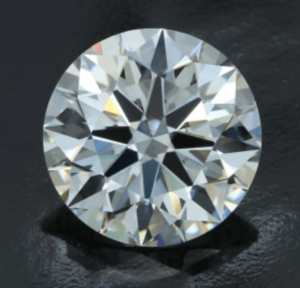 Once you’ve found an eye-clean diamond in the shape you want, and there are no inclusions that can be seen with the naked eye, it’s unnecessary to get a better clarity grade. If luck is on your side, you might be able to find an eye-clean SI1 or SI2 clarity grade diamond. The reason is that when compared to an IF diamond, you wouldn’t be able to see the difference!
Once you’ve found an eye-clean diamond in the shape you want, and there are no inclusions that can be seen with the naked eye, it’s unnecessary to get a better clarity grade. If luck is on your side, you might be able to find an eye-clean SI1 or SI2 clarity grade diamond. The reason is that when compared to an IF diamond, you wouldn’t be able to see the difference!
This does not hold true for diamond color, however!
I hate to admit this, but as experienced as I am, I cannot easily see the difference between a D and an F color-grade diamond. However, I definitely can see the difference between a D and a G color grade. Therefore, the color of the diamond is something you would definitely appreciate when looking at it with your naked eye if you decide to go the extra mile to find a better color grade within your budget.
I hope this article has clarified the difference between diamond color vs. clarity so that you are better informed when shopping for your diamond and know which one to prioritize for the shape you’ve chosen.
The Bottomline

Once you made sure that your diamond is eye clean, color is more important than clarity. Which color grade you choose depends on your ring setting. If you choose a rose gold setting, for example, you can easily pick a diamond at the lower end of the color scale.
It wouldn’t matter if the diamond had a yellow tint. Yellow gold and rose gold settings are likely to swallow any yellow tint your diamond might exhibit.
If you follow my advice and look for relatively low clarity grades and pick a diamond with no visible inclusions to the naked eye, you should be on the safe side! Remember that cut is king, specifically when you choose a quality diamond with a brilliant cut.
So, don’t be afraid to pick lower grade diamonds and make sure to reference the above guides when deciding on color and clarity grades for engagement rings.
Also, if you want to buy a diamond, make sure you go to a reputable vendor such as James Allen or Blue Nile. They offer thousands of loose diamonds with varying color and clarity grades as well as diamond cuts. Whether you fancy a princess cut diamond, a cushion cut diamond, a pear shaped diamond or a classic brilliant diamond, they are likely to have it!

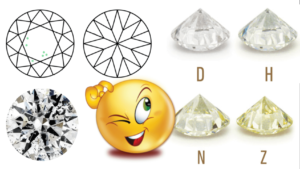
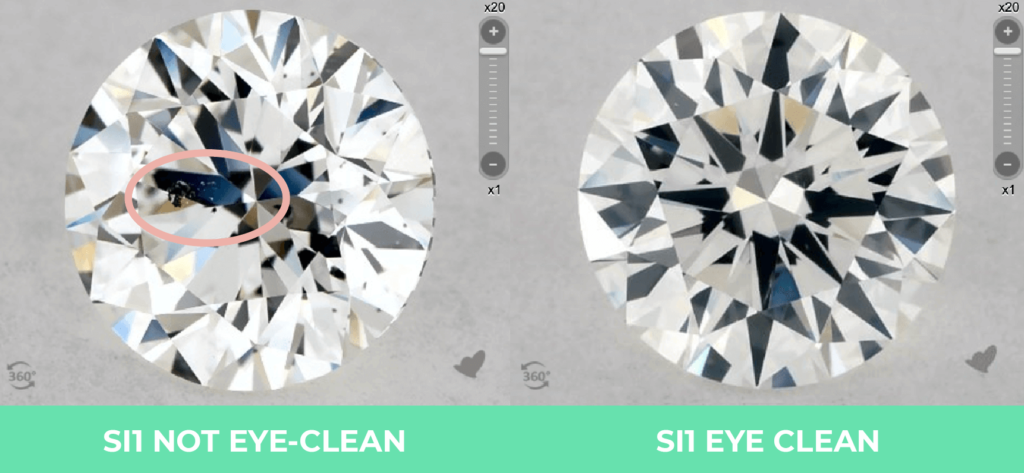
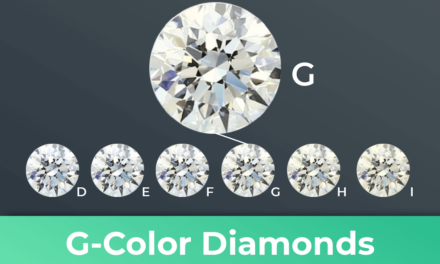
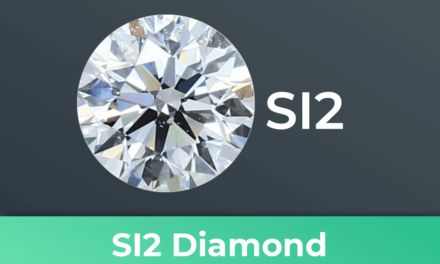
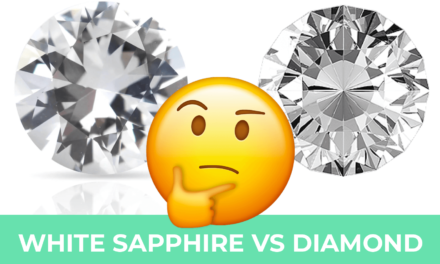



0 Comments